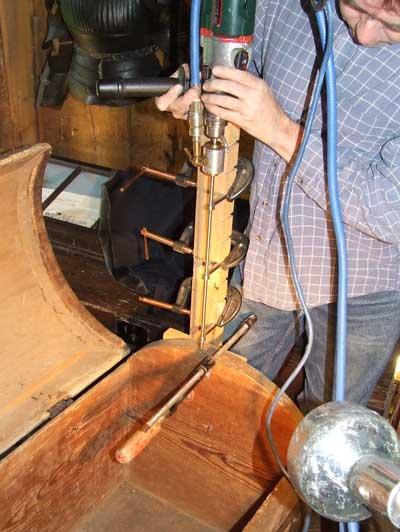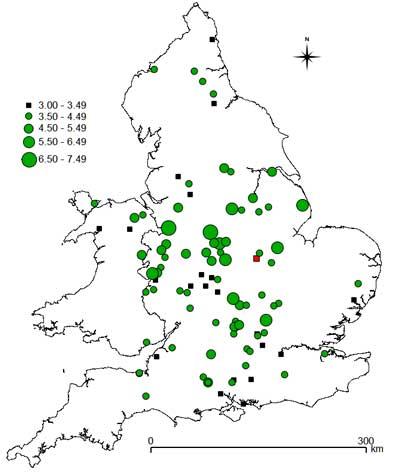The ever increasing database of sites dated through dendrochronology (mostly medieval and post-medieval buildings) in Britain has meant that any new assemblage of oak timbers from those periods has a much higher potential for dating than it did a couple of decades ago, and the information gained has had a great impact on vernacular architectural history, with dates being assigned to well over two and a half thousand building phases throughout the area. This itself has led to more consideration of determining where the source trees may have grown (dendroprovenancing). Other areas of study have also been growing rapidly throughout this period: the investigation of imported oak timbers, and the parallel study of imported softwoods, and attempts to date elm, the second most important building timber in historic buildings. These have all contributed extensively to our understanding of the historic environment.
Impact on Architectural History
One example of the impact on vernacular architectural studies of so many independently dated buildings is the reconsideration of the development of the ‘Snowdonia House’, a particular form of building, the first fully storeyed house-type found in the north-west of Wales. It had long been assumed, based on stylistic evidence and inscriptions on the buildings themselves, that these houses developed in the mid- to late sixteenth century. However, dendrochronological studies over the last fifteen years reported in Suggett and Dunn (2014) show that in fact this innovative house form was present from the early sixteenth century and was fully developed by 1550, although open-hall houses continued to be built into the 1520s. This has totally transformed our understanding of architectural history in the region.
Imported oak
It has long been known that oak boards (traditionally less than 1.5 inches / 38 mm thick) were being imported into Britain from ‘the Baltic’ from the thirteenth century onwards (e.g. Latham 1957, Dollinger 1964, Federowicz 1980, and Hocker 2003), e.g. the nave ceiling boards in Peterborough Cathedral (Groves 2000). At the same time boards were also being brought in from Ireland, as shown by studies at Salisbury Cathedral (Miles 2002). Much of the early work on dendrochronology in this country dealt with the boards used as the substrate for oil paintings (panel paintings) before the use of canvas, although at the time it was not appreciated that most of these boards were not of local origin. Cooper (2011) discusses the fact that over 200 such paintings have now been shown to have used ‘Baltic’ oak boards, though there is still some confusion as many of these boards appear to have been imported to Britain, after being first shipped to the Netherlands from their ‘Baltic’ (often Polish) origins.
Boards have also been dated from chests and other furniture items, as well as doors (Bridge and Miles 2011; 2012), and these highlight the changing origins of this ‘Baltic’ timber. Imports from Germany in the mid-thirteenth century gave way by the end of that century to timber from Poland, later being joined by imports from modern Latvia, Lithuania and Estonia, and much later from Belarus, then finally the ‘Baltic’ trade in oak boards declined during the sixteenth century. Thicker planks were also brought in e.g. to make the tracery in windows at Abingdon Abbey (Oxfordshire). The construction in the late seventeenth century of a more unusual object, a horse in the ‘Line of Kings’ at the Tower of London used blocks of ‘Baltic’ oak up to 120 × 170 mm (approximately 5 to 6.5 inches) thick (Miles pers comm). Although it is sometimes possible to see the end-grain on doors and chests, often the level of cleaning and the removal of patina that would be necessary for dendrochronological investigation would be deemed an unacceptable intervention, so the development by Dan Miles of a microborer that can take 5 mm diameter cores from thin boards has had an enormous impact on the ability to get ring series from chests and doors. To date at least 42 chests of various origins have been dated in Britain, along with more than 50 doors. Surprisingly, some of the ‘dugout’ chests, where a trunk is hollowed out to make a chest, an apparently rather ‘primitive’ way of making a container, have been found to be much later than many carefully crafted pieces of joinery from earlier centuries.
Imported pine
One type of chest, known as a pine standard chest, formed part of the Baltic trade (Simpson 2008, Pickvance 2012), and over 100 such chests have been found in Britain. The presence of two complete chests in a room with a small doorway in Mendlesham church (Suffolk) suggests these may have been transported in ‘kit form’ and made up on site. The Mendlesham chests (Fig. 1) and a similar one at Fordwich in Kent date to the early fifteenth century. Larger pine timbers for structural work were imported at a much later date, mostly from the early seventeenth century onwards, and coming at first from southern Sweden.

One of the fifteenth century pine chests in Mendlesham church being sampled for dendrochronology by Dan Miles (photo by author).
Amongst what survives to the present, pine timbers in Britain are encountered early on in the remains of the oak-built Tudor warship, the Mary Rose, in the form of a repair: an upper deck beam was replaced in pine sometime before the ship sank in 1545. In buildings, pine is first found mostly in the grander constructions of the rich, and as time goes on, it becomes the default option even for more vernacular buildings. Early examples (all seventeenth-century) of early pine roofs include the Apothecaries Hall in the City of London, rebuilt soon after the Great Fire (Bridge 2015), various parts of Hampton Court Palace (Bridge and Miles 2015), and a small roof over part of the Queen’s House, Tower of London (Bridge and Miles in prep ). As we move into the late seventeenth- and early-eighteenth centuries there are many more examples of buildings with imported softwood, both around London and further afield, and a change in origin of the timbers, perhaps reflecting exhaustion of the resource, from Poland and the eastern Baltic, towards southern Norway and Sweden. The trade then appears to revert to more eastern Baltic ports, and towards the end of the eighteenth century there is an increase in wood being imported from North America (Groves and Locatelli 2005).
Elm
Whilst these foreign imports are of great interest, one of the frustrations in British dendrochronological circles over the last few decades has been the lack of dating of buildings constructed using the second most common home-grown building timber, elm. Elm was not as common as ash in the environment, but must have been deliberately chosen for its characteristics in preference to ash. Three elm series had been dated several decades ago, each of them matching oak at the same location. In 2015 one wing of a farmhouse in north Essex was dated by comparison with oak in the same building, and the site chronology formed from three elm timbers matched well against many other oak chronologies from the region (Bridge and Miles 2015). However many elm timbers have been found to contain relatively few rings and often erratic growth patterns, and Richens (1983) has noted that elm is the most genetically diverse of our native hardwood species. These factors have combined to limit the success of dating elm up to now, but Historic England have recently commissioned a project which aims to examine a large number of the most promising looking elm buildings in an attempt to understand more about how useful this timber may be in future dendrochronological studies.
Dendroprovenancing
Now that we have such a network of dated sites across the country, one can reasonably interrogate the dataset with a view to provenancing the origins of the trees used as timber. One area where this might be interesting is in large urban centres, such as London, where the timber had probably been brought in from a large hinterland over many centuries. The dendrochronological textbooks suggest that the site giving the strongest match is the likely geographical origin of the wood, but this is disputed. It seems that when working over large areas, such as Europe, particularly in the areas with a more predictable continental climate, it is possible to highlight the likely growth areas of the trees. However, working at smaller scales with our maritime climate the results are often less clear cut.
Take the example of the site chronology for six timbers from the Old Hall, Belton, Rutland (Miles et al 2008). In the case of matching with other individual buildings (Fig. 2), it would be wrong to simply look at the one strongest match, since the timber for that building may itself have been brought from elsewhere, it is important to look for trends amongst the data. There is no clear geographical trend evident in this case, although it is likely that the timber grew fairly locally to the site itself, say within 20 km.

Map of England and Wales showing levels of statistical agreement (t values – see key) for different geographical site chronologies having at least 50 years overlap, as progressively larger green circles. The chronology for Old Hall, Belton is marked with a red square. Black squares represent other sites with overlapping age ranges that did not give statistically significant matches (map produced by author in open source software QGIS).

